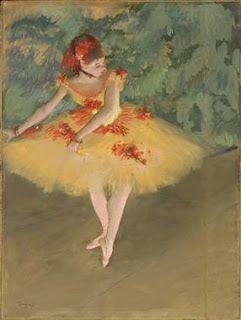Prima Ballerina was painted in Paris around 1876 and
represents a Ballerina from an angle of a catwalk behind the scenes. Edgar
liked to paint scenes of such dancers and completed a number of noteworthy
ballerina scenes. He sought to paint life through a keyhole in a way the
audience will never see it.
He was an impressionist which means he used obvious strokes,
accurate depiction of light, the experience of time, and human experience (1). They sought to find
a way to show life from a new vantage point. Their works were a radical
departure from realism.
This painting is actually not a painting in the traditional
sense. It is a crayon type artistic work. This is not the same as the crayons
of today but a chalk type instrument. It gives a softer image within the work and is
sometimes considered difficult to work with.
When I look at this painting I see an image of backstage
life that others may not be familiar with. It is life in motion. The ballerina is
engage is a graceful dance and appears to be fully engrossed in her art. The
other characters are in blur much the same way you may experience it on a
stage, a ball game, or other public activity when you are in the moment-Flow.
Flow is that special place where nothing else matters. You are simply taking in information and letting it go to create something new. Dancers, painters, sports players, actors, and many others have experienced the timelessness of flow. It is just a state of simply being and enjoying the activity without an reference to the outside world.
Flow is that special place where nothing else matters. You are simply taking in information and letting it go to create something new. Dancers, painters, sports players, actors, and many others have experienced the timelessness of flow. It is just a state of simply being and enjoying the activity without an reference to the outside world.

